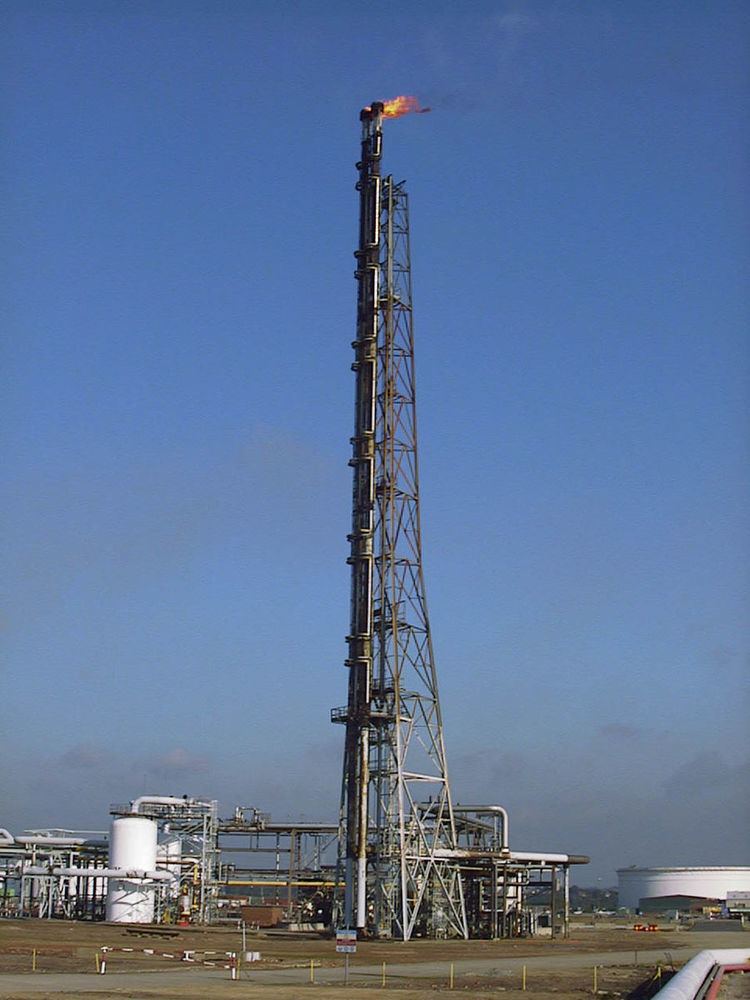 | ||
A gas flare, alternatively known as a flare stack, is a gas combustion device used in industrial plants such as petroleum refineries, chemical plants, natural gas processing plants as well as at oil or gas production sites having oil wells, gas wells, offshore oil and gas rigs and landfills.
Contents
- Overall flare system in industrial plants
- Impacts of waste flaring associated gas from oil drilling sites and other facilities
- References
In industrial plants, flare stacks are primarily used for burning off flammable gas released by pressure relief valves during unplanned over-pressuring of plant equipment. During plant or partial plant startups and shutdowns, flare stacks are also often used for the planned combustion of gases over relatively short periods.
Gas flaring at many oil and gas production sites protects against the dangers of over-pressuring industrial plant equipment. When petroleum crude oil is extracted and produced from onshore or offshore oil wells, raw natural gas associated with the oil is brought to the surface as well. Especially in areas of the world lacking pipelines and other gas transportation infrastructure, vast amounts of such associated gas are commonly flared as waste or unusable gas. The flaring of associated gas may occur at the top of a vertical flare stack (as in the adjacent photo) or it may occur in a ground-level flare in an earthen pit. Preferably, associated gas is reinjected into the reservoir, which saves it for future use while maintaining higher well pressure and crude oil producibility.
Overall flare system in industrial plants
When industrial plant equipment items are over-pressured, the pressure relief valve is an essential safety device that automatically release gases and sometimes liquids. Those pressure relief valves are required by industrial design codes and standards as well as by law.
The released gases and liquids are routed through large piping systems called flare headers to a vertical elevated flare. The released gases are burned as they exit the flare stacks. The size and brightness of the resulting flame depends upon the flammable material's flow rate in joules per hour (or btu per hour).
Most industrial plant flares have a vapor-liquid separator (also known as a knockout drum) upstream of the flare to remove any large amounts of liquid that may accompany the relieved gases.
Steam is very often injected into the flame to reduce the formation of black smoke. When too much steam is added, a condition known as "over steaming" can occur resulting in reduced combustion efficiency and higher emissions. To keep the flare system functional, a small amount of gas is continuously burned, like a pilot light, so that the system is always ready for its primary purpose as an over-pressure safety system.
The adjacent flow diagram depicts the typical components of an overall industrial flare stack system:
Impacts of waste flaring associated gas from oil drilling sites and other facilities
Improperly operated flares may emit methane and other volatile organic compounds as well as sulfur dioxide and other sulfur compounds, which are known to exacerbate asthma and other respiratory problems. Other emissions from improperly operated flares may include, aromatic hydrocarbons (benzene, toluene, xylenes) and benzapyrene, which are known to be carcinogenic.
Flaring can affect wildlife by attracting birds and insects to the flame. Approximately 7,500 migrating songbirds were attracted to and killed by the flare at the liquefied natural gas terminal in Saint John, New Brunswick, Canada on September 13, 2013. Similar incidents have occurred at flares on offshore oil and gas installations. Moths are known to be attracted to lights. A brochure published by the Secretariat of the Convention on Biological Diversity describing the Global Taxonomy Initiative describes a situation where "a taxonomist working in a tropical forest noticed that a gas flare at an oil refinery was attracting and killing hundreds of these [hawk or sphinx] moths. Over the course of the months and years that the refinery was running a vast number of moths must have been killed, suggesting that plants could not be pollinated over a large area of forest".
As of the end of 2011, 150 × 109 cubic meters (5.3 × 1012 cubic feet) of associated gas are flared annually. That is equivalent to about 25 per cent of the annual natural gas consumption in the United States or about 30 per cent of the annual gas consumption in the European Union. If it were to reach market, this quantity of gas (at a nominal value of $5.62 per 1000 cubic feet) would be worth $29.8 billion USD.
Also as of the end of 2011, 10 countries accounted for 72 per cent of the flaring, and twenty for 86 per cent. The top ten leading contributors to world gas flaring at the end of 2011, were (in declining order): Russia (27%), Nigeria (11%), Iran (8%), Iraq (7%), United States (5%), Algeria (4%), Kazakhstan (3%), Angola (3%), Saudi Arabia (3%) and Venezuela (3%).
That amount of flaring and burning of associated gas from oil drilling sites is a significant source of carbon dioxide (CO2) emissions. Coupled with fossil fuel combustion and cement production, flaring's carbon dioxide emissions in 2010 have tripled (1300 ± 110 GtCO2) compared to the last recording (years 1750-1970, 420 ± 35 GtCO had been emitted.) 2400 × 106 tons of carbon dioxide are emitted annually in this way and it amounts to about 1.2 per cent of the worldwide emissions of carbon dioxide. That may seem to be insignificant, but in perspective it is more than half of the Certified Emissions Reductions (a type of carbon credits) that have been issued under the rules and mechanisms of the Kyoto Protocol as of June 2011.
Satellite data show that from 2005 to 2010, global gas flaring decreased by about 20%. The most significant reductions in terms of volume were made in Russia (down 40%) and Nigeria (down 29%).
